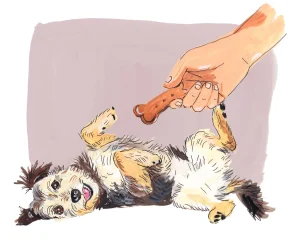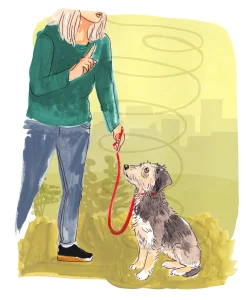When people find out you’re having a baby, you hear a lot of “Congratulations!” and “Mazel tov!” I heard a lot of: “How is Marvin ever going to cope?”
It was a reasonable question. Marvin is our dog—adorable, affectionate, anxious, liberally medicated. We rescued him during the pandemic, and he has earned more than his fair share of press—including in Dogue and the New York Post, the two true papers of record—for the heart-warming tale of his Upper West Side confab with the sons we at the time didn’t know he had. His children turned out to have also made the trek from a shelter in Texas to New York, and were placed with new owners who lived within 20 blocks of us. CBS News filmed their reunion.
Unaware of his fame, Marvin soon settled into a nice uptown life, barking at teenagers on skateboards, women with backpacks whom he deemed suspicious, Fresh Direct drivers, German shepherds, and several inanimate objects. After a period of crippling separation anxiety, he got on Prozac and an expensive speciality diet, submitted to some basic training so that he could handle the elevator, and seemed to acclimate relatively well to metropolitan life. He would never be an “off-leash” dog, so we sometimes had to banish him to our bedroom when our parents came over after he developed strangely durable grudges against both of our moms. So what! We managed.
But then we decided to have a baby, and Marvin—with his history of yelping at our doormen, scratching at innocent visitors, and generally causing mayhem—was put on notice. At least, I was putting him on notice. At the same time, my husband was testing out different coping mechanisms to deal with this imminent disruption in our lives and his—like telling people that he was sure it would all be fine while looking vaguely stricken, or googling “anxious dog newborn” and then slamming his laptop shut.
Admirable approaches from both of us—neither of which resulted in Marvin learning to tolerate strangers, see sense, adapt to changes in his routine, or accept the fact that his position at the center of our universe would soon be contested.
 I got pregnant. I got more pregnant. Nine months and all of a sudden later, I was about to have an actual human child in a matter of weeks, and I had a dog who lunged at shadows that passed over his corner of the living room.
I got pregnant. I got more pregnant. Nine months and all of a sudden later, I was about to have an actual human child in a matter of weeks, and I had a dog who lunged at shadows that passed over his corner of the living room.
I needed help. Which is around when I was introduced to Kate Perry Dog Training. (No, not that Kate Perry.) I would soon learn that this Kate is renowned in the tristate area for her expert handling of the toughest cases, the baddest puppies, the most misunderstood dogs. Her credentials are sterling: best dog trainer in New York (according to New York magazine); writer of a bible called Training for Both Ends of the Leash that has been updated and reissued multiple times; walker and trainer to the dogs of famed photographers, titans of business, and Jon Stewart. (She is too discreet to shout about her clients, but rumor has it she is AWOKed.)
Of course, I didn’t get around to calling her until our son was two months old. Marvin had gotten into the habit of terrorizing our baby nurse in the middle of the night, and I was down to my absolute very last frayed nerve. But those are all ancient memories now.
Because a few glorious months ago, Kate arrived at our door. And like a canine Mrs. Piggle-Wiggle, she got to work. So did we. Under her instruction, we filled out numerous worksheets. We had to record covert footage of Marvin in his “problem areas.” We submitted to a session of what can best be described as an hour of deep psychoanalytic processing. Marvin growled. Marvin whined. And in the end, with a lot of repetition, a new protocol around distraction, and actual begging, Marvin kind of relented?
This fall, our son will turn one, and while Marvin still doesn’t like Fresh Direct deliveries, his behavior has improved, his demeanor is more placid, and his recall is… well, that part is still quite bad. But who needs recall?
With Kate’s permission, I’m sharing some of her top tips for gorgeous, perfect, demented—no, she would not use that word—dogs and how to live with them. What follows is not parenting advice, but it could be.
Give Them a Place
Kate calls herself a social worker for dogs—and the role suits her. She has a legalistic mind and an empathetic heart. Also, she loves order. At our apartment, she rearranges Marvin’s bed to give him a quiet retreat so that he can establish a safe space far from the front door and us. With high-value treats, we practice luring Marvin there to cement a positive association. We attempt to teach him the command “place!” to make him go there, but it doesn’t take. Still, he seems to grasp the concept. Now when we have people over, he seeks shelter on his bed or in his crate and, for the most part, leaves us all alone.
Give Them a Task
“He’s what I call a social misfit,” Kate pronounces, describing sweet Marvin as the outcast I have long known him to be. “He’s a quirky social misfit, and he doesn’t know what to do. You have to tell him what to do.”
As soon as Kate meets Marvin, she identifies him as more worker than attack dog. He longs for instruction. We need to give it to him. That means exhausting some of his nervous energy with puzzles and games, tossing treats in the general direction we want him to go, and not letting him stand with us near the door, expectant, when we’re getting a package.
Kate likes a particular three-point game: “Touch, look at me, go find it.” She teaches me to hold a treat, make Marvin sniff it out nose to palm, and throw it to get him scrambling for his reward. Ten rounds in, he’s practiced his focus and tuckered himself out.
Create New Associations
“Behavior modification with an older dog?” Kate whistles. “We’ve got deep history and a lot of layers that make for a complicated picture, so we need to create a new picture. It’s going to take time to put together.”
The doorbell has long been a major Marvin trigger. So is me so much as uttering the word “coming!” while walking toward it. He knows that sound portends visitors. He does not like visitors. Kate encourages one of us to ring the bell at random intervals, while the other plies Marvin with treats before he can start barking.
Doorbell = treats. Doorbell = good. Let’s face it: He still barks 50% of the time, but that’s real improvement!

Let Them Know You Mean It…
Kate is a proponent of positive reinforcement. (Scroll dog Reddit for three minutes and get an instant sense of the extreme animus that persists between the positive reinforcement and “correction-based” dog training movements.)
Still, she isn’t opposed to a nudge in the right direction. We now keep a plastic spray bottle in high-traffic areas to communicate to Marvin that we do not love it when he, for example, stands on the back of our couch for a loftier perch from which to bark at us. Kate shows us how to spritz while declaring “enough!” in an authoritative voice.
…But Empty Threats Can Also Work
Of course, my husband refuses to use the bottle, which he deems cruel. But since I—the cold-hearted parent—have complied, just the word enough now tends to stop Marvin in his tracks. It has not prevented him from sanding down one of our son’s expensive wooden blocks with his teeth, but it has saved numerous others from the same fate.
Have a Backup Plan
“With a baby, 80% of it is management,” Kate tells me. She means it’s all well and good to work on Marvin’s barking and to help him deal with the parade of guests who now waltz through our door, but unpredictable dogs and newborns are not meant to mix. The aim of our training is not to have our son and Marvin take naps together; it’s to have them coexist without much direct contact. “We have to help make Marvin feel safe, and that doesn’t mean petting him and being like, ‘It’s okay, Marvin,’” as Kate puts it. “He won’t understand that. We make him feel safe with boundaries.”
Marvin has his place. Now our son does too. As soon as he starts crawling, he becomes the second member of this household to have a peaceful enclosure to call his own. We order an all-pine pen from Amazon, choose a rather fetching patterned foam playmat from the British brand Totter + Tumble, and set up a zone for him in the living room. Marvin is banned from the area, although he does gaze at it with an undeniable longing. Learning to live with disappointment—classic oldest child.
Original Article Can Be Found here:
https://www.vogue.com/article/marvin-celebrity-dog-trainer-dogue-2025

